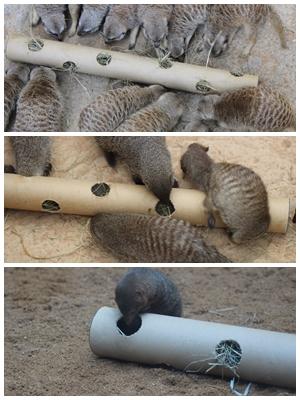Animals and management
This study focuses on three species of the family Herpestidae (meerkat, banded mongoose and dwarf mongoose), which are small terrestrial carnivores that live in social groups. The three target groups live in Bioparc Valencia (Spain) and they were studied between June and November 2019.
- The group of meerkats (Suricata suricatta) was formed by 17 individuals, 7 females and 10 males.
- The group of banded mongooses (Mungos mungo) was formed by 6 adult individuals, 4 males and 2 females.
- The group of dwarf mongoose (Helogale parvula) was formed by 6 individuals, 4 males and 2 females.
Enrichment study

Behaviour baseline study
To study how animals behave in the presence of these new enrichments, first, a behaviour baseline study was carried out to act as a control group. This study was conducted following a scan sampling method with intervals of one minute and during sessions of one hour, in which the number of individuals engaged in the different behaviour states was noted. The behaviours performed by the animals were recorded according to an ethogram.
Food enrichment study
In this experiment, a cardboard tube 076.5 x 080.0 x 0750 mm with two black caps at the ends was used (Figure 1). This enrichment aimed to simulate a tree trunk for increasing the foraging behaviour of these species. This enrichment was presented with three different variations. The first one was the tube with hay acting as a potential object to forage. The other two variations aimed to test the foraging tube as a food enrichment, adding mealworms (larvae of Tenebrio molitor) into the hay, which could only escape through the holes. The difference between these two versions was the number of mealworms, one being the double of the other.
The same scan sampling method described above was used to record how animals behave in the presence of the enrichment. Also, as a method of testing the success, it was recorded the total time that animals (irrespective of the number of animals) interacted with the enrichment using a chronometer.
Olfactory enrichment study
To test the effects of olfactory enrichment, two new odours were used. To resemble as much as possible what they might encounter in their natural habitat, these two odours were from two different species that they could encounter in nature. The two species selected were a potential predator, the hyena (Crocuta crocuta), and a herbivore, the elephant (Loxodonta africana). The presentation of the smells was done by placing one sample of excrements in their enclosure.
The scan sampling method, previously described, was used to record their behaviour in the presence of both odours. The time spent interacting with each olfactory enrichment was also recorded.
Responsible for this page:
Director of undergraduate studies Biology
Last updated:
05/09/20
